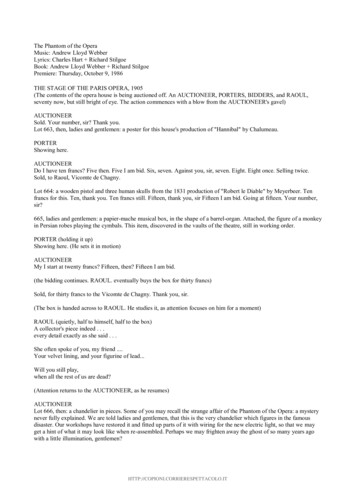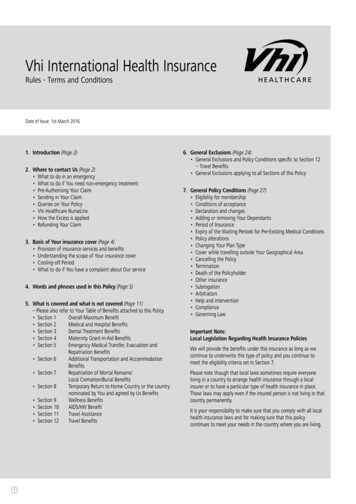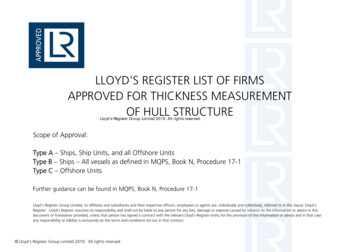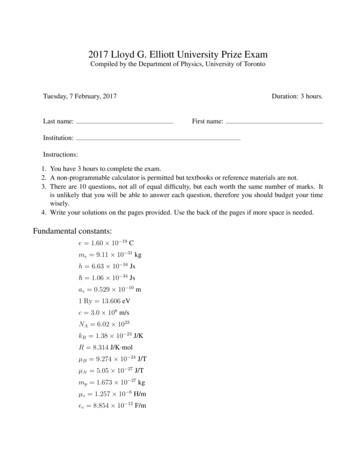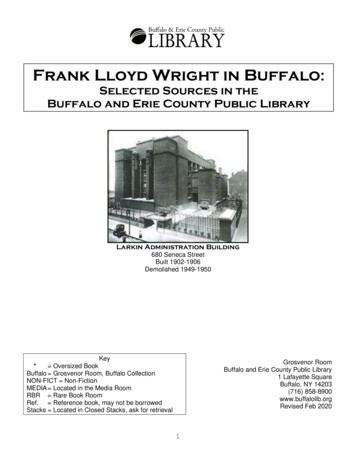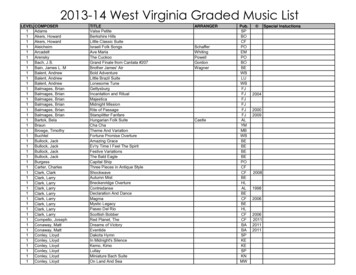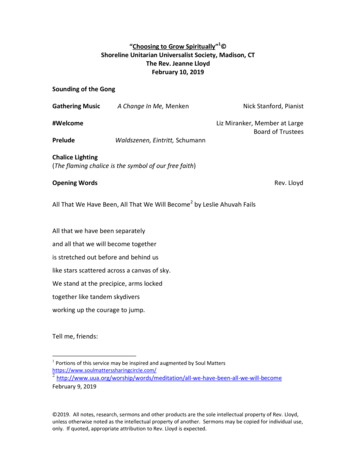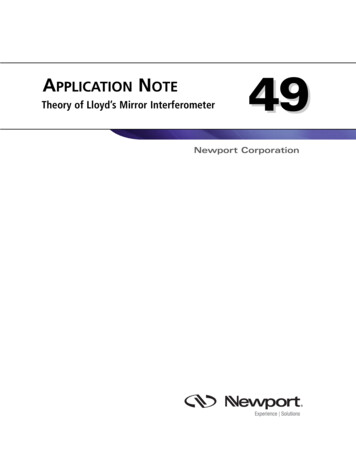
Transcription
Stacey Lloyd 2014
Thank you for downloading this product I hope that these notes and worksheets prove useful to your students. Please don’t hesitate toemail me if you have any questions or queries, and know that feedback is always appreciated.Warm regards Stacey LloydEmail:Stacey - ‐Lloyd- ‐8481CONTENTS & IDEAS FOR USEPAGEWORKSHEETWHAT IS IT?IDEAS FOR USE120TechniquesofPersuasiveLanguageThisone- hniquesused.writingexercise. Stacey Lloyd 2014
20 Techniques of Persuasive LanguageExamples of persuasive language are all around us: in advertising, politics, editorials, and reviews (justto name a few). It is important to understand techniques of persuasion so that you can identify andanalyze them in use, but also so that you can utilize them in your own writing and speech.Adjectives are descriptive words used to addemphasis and to create an emotional response.Alliteration is the repetition of initialconsonant sounds in order to emphasize certainwords and make them more memorable.Anecdotes are short personal stories used toconnect with the audience and add evidence orcredibility to an argument.Assertion is when an idea is presented as factwithout full explanation or evidence; it is used toassert authority and make claims sound factual.Attacks are when a speaker/writer addressesan opposing view or speaker and attacks theirargument or character.Bias is the presentation of only one side of anissue or viewpoint and is used to subjectivelyinfluence an audience.Connotation is the ideas or feelings that acertain word invokes and is used to create certainemotional responses in an audience.Credibility (Ethos) is the establishment ofauthority and reliability, and is used gain theconfidence and trust of the audience.Emotion (Pathos) is feelings accentuated byEvidence is the facts or information thatindicate whether a view is true or valid and isused to give weight to an argument or belief.Figurative Language is used to createimagery and express things non-literally; it canhelp to make an idea more emotive, vivid andconvincing.Generalization is the inference that a claim istrue for most people or a majority and is used tospeak to prevailing beliefs or prejudices of anaudience.Rule of Three is when groups of 3 adjectivesor phrases are used to make ideas memorable.Jargon is special words or expressions used by aprofession or certain group; it is used to signalexpertise and establish credibility.Loaded Words are words charged with anunderlying meaning or implication and are usedto produce emotion in an audience.Pronouns are words that take the place ofnouns and are used to create a sense of unity withan audience or distance from a common enemy.Reason (Logos) is the power of the mind tothink and form judgments logically; it is used toappeal to the rationality of an audience.experiencing love hate, fear etc. An appeal toemotion is used to engage with an audience andcreate an emotional response.Repetition is the reoccurrence of certain wordsExaggeration is the representation ofRhetorical Questions are statements whichsomething as greater than is actually the case andis used to grab the attention of the audience andemphasize certain points.or phrases and it is used to emphasize certainideas, and make them more memorable.are voiced as questions but are not expected to beanswered; they are used to imply certain answersand draw audiences to certain conclusions. Stacey Lloyd 2014
For each of the following advertising extracts, identify the persuasivelanguage technique being used, and explain how it is persuasive.12 Love comfort. Love value.Love Super Soft Sofas.345Percy’s PencilssCelebrity stylist Rob HallmupseooNature’s Nectar sha6Do you want to take care of your family’s health?VITA-HEALTH VITAMINSSupplements for men, women & children7.8 Lee’s Pre-Cooked Mealserybody needs a littleBecause evmore free time.in advertising Stacey Lloyd 2014
For each of the following advertising extracts, identify the persuasivelanguage technique being used, and explain how it is persuasive.A NSWERKE Yin advertising1)Logos is employed here as the advertiser has usedstatistics to try to persuade the consumer that theirproduct is the rational choice, and backed up by ‘fact’.12)Here is an example of Repetition - or specifically, Anaphora: Therepeated ‘love’ emphasizes it, and has positive connotations,thus making the product attractive and associated with ‘love’.Super Soft Sofas.Also, there is alliteration in the name of the product (alliterative‘s’), which makes it more memorable.3)This one uses Figurative Language and more specifically,a pun. It’s a play on the word ‘nail’ and is persuasive asnails (as in the hardware) are strong and durable,which is what one wants from a nail polish.Percy’s Pencils4)Alliteration is used here (repeated ‘p’) as well as a listof 3 adjectives: Both of which make this memorable.5)This is an example of ethos as it appeals to thempooexpertise of a celebrity stylist. Therefore, it addsNature’s Nectar shacredibility to their product. Also the ‘n’ is alliterative.Do you want to take care of your family’s health?6)The rhetorical question here is also an example ofpathos as it is playing on the reader’s emotional loveSupplements for men, women & childrenfor their family, and their concern for their health.There is also a list of 3 which makes it memorable.7)The descriptive adjectives ‘new’ and ‘improved’ have positiveconnotations and add emphasis. Also, the jargon signalsknowledge, research and expertise and thus employs logos .Assertion is used in the statement “.everybody needsooked Mealilsttle 8)Lee’s Pre-Codsaa little more free time.” – This makes it sound like anBecause everyb eey tinemede.irrefutable fact, which is persuasive.more fr2 Love comfort. Love value.Love345sCelebrity stylist Rob Hall use6VITA-HEALTH VITAMINS78 Stacey Lloyd 2014
Read the following extract from a famous political speechby Winston Churchill, and then fill in the table below.in a political speechExtract from “Blood, Toil, Tears & Sweat”“We have before us an ordeal of the most grievous kind. We have before usmany, many long months of struggle and of suffering. You ask, what isour policy? I can say: It is to wage war, by sea, land and air, with all ourmight and with all the strength that God can give us; to wage war againsta monstrous tyranny, never surpassed in the dark, lamentable catalogueof human crime. That is our policy. You ask, what is our aim? I cananswer in one word: It is victory, victory at all costs, victory in spite of allterror, victory, however long and hard the road may be; for withoutvictory, there is no survival. Let that be realized; no survival for theBritish Empire, no survival for all that the British Empire has stood for,no survival for the urge and impulse of the ages, that mankind will moveforward towards its goal. But I take up my task with buoyancy and hope. Ifeel sure that our cause will not be suffered to fail among men. At thistime I feel entitled to claim the aid of all, and I say, ‘Come then, let us goforward together with our united strength.’”TECHNIQUEEXAMPLEWinstonChurchillwas aBritishpoliticianand PrimeMinister of the United Kingdomduring the Second World War.He was also an excellent publicspeaker, artist and writer.This extract comes from aspeech he delivered on May 13th1940. He had just been madePrime Minister of the UnitedKingdom and it was the firstyear of WWII.EFFECTRule ofThreeUse oricalQuestion Stacey Lloyd 2014
Read the following extract from a famous political speechby Winston Churchill, and then fill in the table below.Ansin a political speechKeExtract from “Blood, Toil, Tears & Sweat”“We have before us an ordeal of the most grievous kind. We have before usmany, many long months of struggle and of suffering. You ask, what isour policy? I can say: It is to wage war, by sea, land and air, with all ourmight and with all the strength that God can give us; to wage war againsta monstrous tyranny, never surpassed in the dark, lamentable catalogueof human crime. That is our policy. You ask, what is our aim? I cananswer in one word: It is victory, victory at all costs, victory in spite of allterror, victory, however long and hard the road may be; for withoutvictory, there is no survival. Let that be realized; no survival for theBritish Empire, no survival for all that the British Empire has stood for,no survival for the urge and impulse of the ages, that mankind will moveforward towards its goal. But I take up my task with buoyancy and hope. Ifeel sure that our cause will not be suffered to fail among men. At thistime I feel entitled to claim the aid of all, and I say, ‘Come then, let us goforward together with our united strength.’”weryWinstonChurchillwas aBritishpoliticianand PrimeMinister of the United Kingdomduring the Second World War.He was also an excellent publicspeaker, artist and writer.This extract comes from aspeech he delivered on May 13th1940. He had just been madePrime Minister of the UnitedKingdom and it was the firstyear of WWII.TECHNIQUEEXAMPLEEFFECTRule ofThree‘. by sea, land andair.’By listing points in sets of three, they are made more memorable andemphasized. Here, the instructions for war are listed as three points andthus made clear and highlighted.Use ofPronouns‘We’ / ‘I’Using ‘we’ helps Churchill to include himself with his audience whichcreates a shared sense of purpose and unity. However, when he switchesto ‘I’ he indicates his sense of personal duty and confidence, as heassures his audience of his responsibility.Credibility(Ethos)‘.all the strength thatGod can give us;’By mentioning God here, Churchill is implying that God is for them, whichadds credibility to their cause. Similarly, it implies he holds Christian views,which – to an audience of the time – would make him trustworthy.LoadedWords‘Victory’He repeats this word five times and it is loaded with underlying meaning. Itis positively connoted and appeals to the emotions of his audience – mostnotably their patriotic feelings and desire to win the war.Anaphora‘to wage war.’(repeated twice) / ‘nosurvival.’ (repeated 3times)These uses of anaphora (repetition at the beginning of successive clauses)reinforce the idea that they must go to war / the idea that withoutvictory there will be no existence worth living. This repetition emphasizesChurchill’s point and makes it memorable.Alliteration‘wage war’RhetoricalQuestion‘You ask, what is ourpolicy?’ / ‘You ask,what is our aim?’Alliteration is used to emphasise and make the words more memorable.Churchill doesn’t expect to have these questions answered as he answersthem himself. He uses them by way of showing awareness of theirconcerns and addressing them. It is persuasive in that he answers anyopposing thoughts and questions his audience might have. Stacey Lloyd 2014
Every 8 seconds somebody dies from tobacco use. Do you really want tobe a part of that statistic?Evidence (logos) / Rhetorical Question Stacey Lloyd 2014
If you like this product, you may alsolikethese:Click on theseSave over 20% and get 5 great products forteaching PERSUASIVE LANGUAGEGet Bonus Material.Save BIG by buying in bundles!SAVE 5 20% OFF Stacey Lloyd 2014
Stacey Lloyd 2014 Thank you for downloading this product I hope that these notes and worksheets prove useful to your students. Please don't hesitate to

